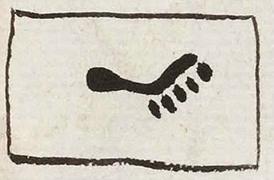Cuachquetzaloyan (Mdz30r)
This compound glyph for the place name Cuachquetzaloyan includes a large, white, rectangular piece of cloth or a cape (cuachtli) and a black footprint superimposed in the middle of the cloth evokes the verb quetza, to stand up. The locative suffix (-yan) is not visible.
Stephanie Wood
Footprint glyphs have a wide range of translations. In this collection, so far, we can attest to yauh, xo, pano, -pan, paina, temo, nemi, quetza, otli, iyaquic hualiloti, huallauh, tetepotztoca, totoco, -tihui, and the vowel "o." Other research (Herrera et al, 2005, 64) points to additional terms, including: choloa, tlaloa, totoyoa, eco, aci, quiza, maxalihui, centlacxitl, and xocpalli.
The -lo- (impersonal) and the -yan (locative suffix, which attaches to verbs and indicates customary action) both point to a verb at the heart of this place name. Besides to stand or stand something up, quetza can mean to raise or erect. Frances Karttunen sees "cuach" are referring to a large cotton sheet, and she interprets "quetzalo" as "to raise something up" or "to stand something up." For her, furthermore, the "yan" adds that this is the place where cotton gets raised up customarily.
Berdan and Anawalt explored the verb quequeza, to tread on, and the noun quetzalli, something precious. They add quetzalo, as "the act of making something precious." But they do not choose those elements in their translation, which they see at the place where fine cotton mantas (blankets, capes) are made.
Perhaps this verb is meant to serve as a phonetic indicator for quetzalli (quetzal birds or feathers), which may have been employed to beautify the fabric. And perhaps this special fabric is known as coming from this town.
Stephanie Wood
quachqueçaloyā. puo
Cuachquetzaloyan, pueblo
Stephanie Wood
c. 1541, or by 1553 at the latest
Stephanie Wood
cloths, mantas, capes, huellas, footprints, icximachiyotl, xocpalli, icxipamitl, stand, parar, a pie, Quachqueçaloyan, Quachquetzaloyan, nombres de lugares

cuach(tli), cape or large cloth, https://nahuatl.wired-humanities.org/content/cuachtli
quetza, to stand, https://nahuatl.wired-humanities.org/content/quetza
quetzal(li), quetzal bird or feathers, https://nahuatl.wired-humanities.org/content/quetzalli
-lo- (passive tense indicator), https://nahuatl.wired-humanities.org/content/lo
-yan (locative suffix), place where [the verb] is customarily carried out, https://nahuatl.wired-humanities.org/content/yan
"Where Cotton Cloth is Customarily Raised Up"[Frances Karttunen, unpublished manuscript, used here with her permission.]
"Where They Make Fine Cotton Mantas" (Berdan and Anawalt, 1992, vol. 1, 200)
"El Lugar Donde Se Levantan Las Mantas"
Stephanie Wood
Codex Mendoza, folio 30 recto, https://digital.bodleian.ox.ac.uk/objects/2fea788e-2aa2-4f08-b6d9-648c00..., image 70 of 188.
The Bodleian Libraries, University of Oxford, hold the original manuscript, the MS. Arch. Selden. A. 1. This image is published here under the UK Creative Commons, “Attribution-NonCommercial-ShareAlike 3.0 License” (CC-BY-NC-SA 3.0).




